February 2 , 2008
Results of a new study find that people living in the state of Maryland are among the least depressed in the US. This is the first such a study to rank states based on the amount of people living in the country that have been treated for some form of depression at one time or another. "No state should be satisfied with the level of depression they have," said Dr. David L. Shern, head of Mental Health America. "I am very confident that we can drive these rates lower. No one should be satisfied, but some states are perhaps doing a better job than other states."
The study ranked the state of Maryland 5th in the category of being home to the least amount of depressed people, and 8th in lowest suicide rate. South Dakota was found to be the least depressed state. "What (the report) shows is that we have a good private health sector in Maryland and we also have a good public health sector," said Brian Hepburn, director of the state's Mental Hygiene Administration. "Does that mean that it can't be better? No. There are things we work on every day to try and improve mental health care."
The national average when it comes to Americans who at one point or another have reported a depressive event is around 9 percent. Spanning 2004 to 2005, only 7 percent of people living in the state reported having any such episode. "The thinking (has been) if you have a mental illness, you're screwed. It's over, you're stigmatized," said Dr. Reef Karim, an attending psychiatrist from the UCLA Neuropsychiatric Institute who attended the press conference. "(But) times have changed." Other states such as Indiana did not fair as well according to the results from the study. Out of the 50 states, they were ranked 39th, with 8.9 percent of adults reporting at least 1 depressive episode. The top 10 depressed states according to the study findings are: Utah, West Virginia, Kentucky, Rhode Island, Nevada, Oklahoma, Idaho, Missouri, Ohio, Wyoming.
Four different measures of depression and mental health status were used to develop one composite measure of the level of depression in a given state. The four measures were: (1) the percentage of the adult population experiencing at least one major depressive episode in the past year, (2) the percentage of the adolescent population (ages 12 to 17) experiencing at least one major depressive episode in the past year, (3) the percentage of the adult population experiencing serious psychological distress, and (4) the average number of days in the past 30 days in which the population reported that their mental health was not good.
Age-adjusted suicide rates were also examined since suicide is the most significant negative outcome of depression.
State Ranking on Depression Status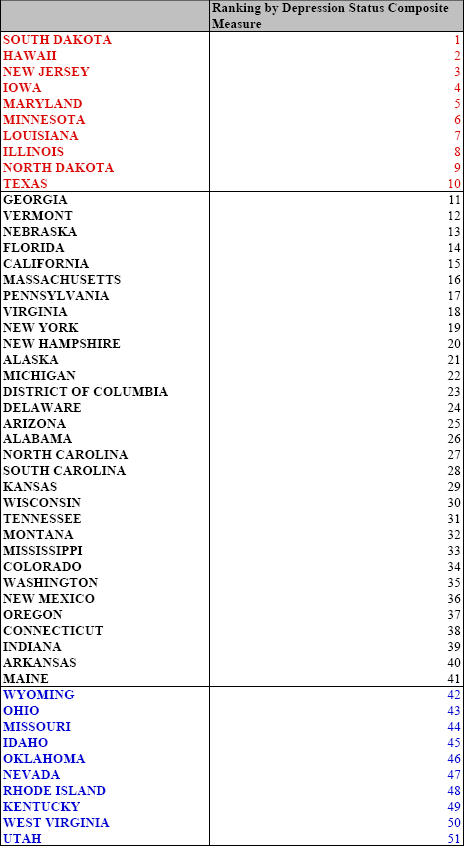
State Ranking on Suicide Rates
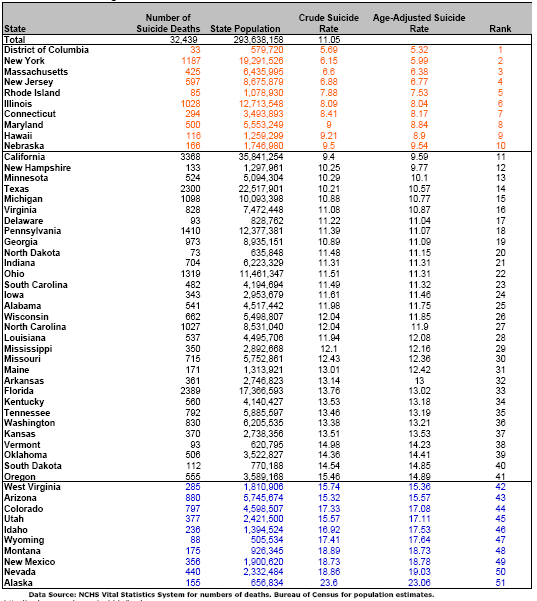
The Top and Bottom 10 States
South Dakota was the healthiest state with respect to depression status. Among adults in South Dakota, 7.31 percent had a major depressive episode in the past year and 11.16 percent experienced serious psychological distress. Among adolescents in South Dakota, 7.4 percent had a major depressive episode in the past year. On average, individuals in South Dakota reported having 2.41 poor mental health days in the past 30 days.
Utah was the most depressed state. Among adults in Utah, 10.14 percent experienced a depressive episode in the past year and 14.58 percent experienced serious psychological distress. Among adolescents in Utah, 10.14 experienced a major depressive episode in the past year. Individuals in Utah reported having on average 3.27 poor mental health days in the past 30 days.
In terms of 2004 suicide rates, the District of Columbia was the lowest, followed by New York and Massachusetts. Alaska had the highest suicide rate, followed by Nevada and New Mexico.
The Five Factors Affecting Depression Status
While many factors likely contribute to these differences which are not represented in the state summary data employed in these analyses, a clear and compelling theme emerges from the data included. The availability of and access to mental health services improves mental health outcomes. This is particularly true for suicide, where less difficulty in obtaining needed care, actual utilization of services, and the availability of a professional workforce are all related to decreased rates of death. Similarly, access to health insurance - a key variable in obtaining care - is also related to decreased rates of suicide.
In "Ranking America's Mental Health," Mental Health America found statistically significant associations between the following factors and better depression status and lower suicide rates:
- Mental health resources - On average, the higher the number of psychiatrists, psychologists and social workers per capita in a state, the lower the suicide rate.
- Barriers to treatment - The lower the percentage of the population reporting that they could not obtain healthcare because of costs, the lower the suicide rate and the better the state's depression status. In addition, the lower the percentage of the population that reported unmet mental healthcare needs, the better the state's depression status.
- Mental health treatment utilization - The higher the percentage of the population receiving mental health treatment, the lower the suicide rate.
- Socioeconomic characteristics - The more educated the population and the greater the percentage with health insurance, the lower the suicide rate. The more educated the population, the better the state's depression status.
In addition, the report found the following factor to be significantly associated with the level of mental health service utilization in a state:
Mental health parity - The more generous a state's mental health parity coverage, the greater the number of people in the population that receive mental health services.
Factors That Influence State Mental Health Status and Suicide Rates

The Five Suggested Public Policy Solutions
The report provides a snapshot of the level of mental health of each state's population, particularly depression - from the "healthiest" state in terms of depression status to the least. Importantly, it links that data to a number of factors that are significantly associated with better depression status and lower suicide rates, and thus provides for the first time a statistical foundation for pathways to reduce depression and its profound consequences. Specifically, the analyses suggest that the following factors reduce depression and suicide:
- Improving the availability of mental health professionals
- Reducing cost and other barriers to mental health treatment
- Encouraging appropriate utilization of mental health therapies
- Providing a richer socioeconomic environment by improving education levels, economic status and health insurance coverage
- Legislating mental health benefits that are equivalent to that for physical health
Additional Charts
Having At Least One Major Depressive Episode in Past Year among Persons Aged 18 or Older, by State: Percentages, Annual Averages Based on 2004 and 2005 NSDUH
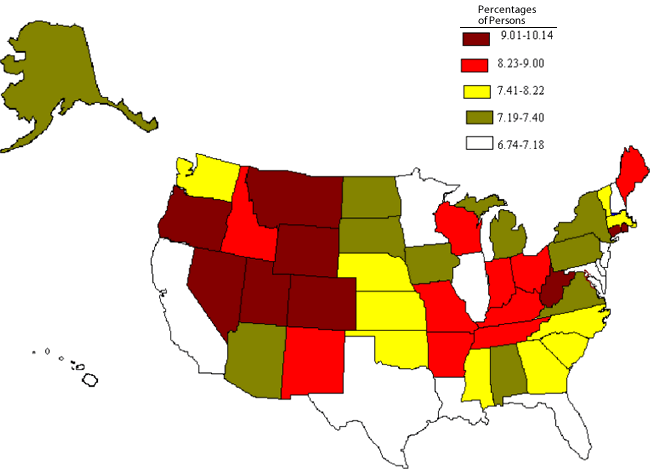
Source: SAMHSA, Office of Applied Studies, National Survey on Drug Use and Health, 2004 and 2005.
Having At Least One Major Depressive Episode in Past Year among Youths Aged 12 to 17, by State: Percentages, Annual Averages Based on 2004 and 2005 NSDUH
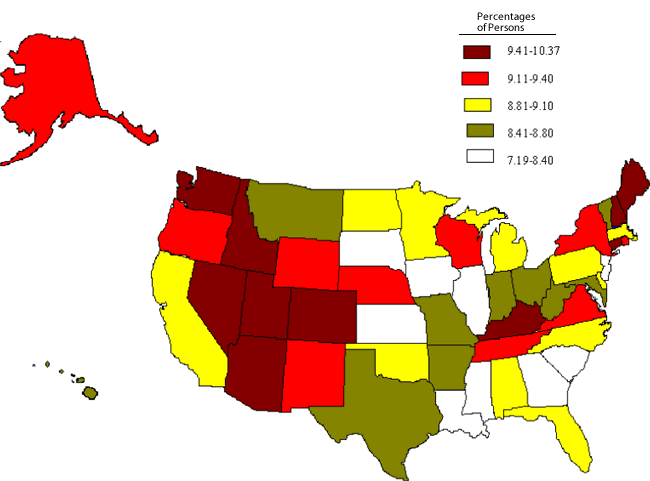
Source: SAMHSA, Office of Applied Studies, National Survey on Drug Use and Health, 2004 and 2005.
Serious Psychological Distress in Past Year among Persons Aged 18 or Older, by State: Percentages, Annual Averages Based on 2004 and 2005 NSDUH
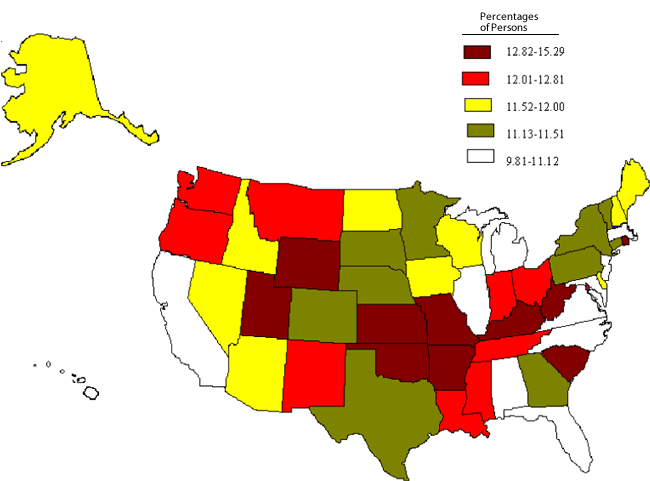
Source: SAMHSA, Office of Applied Studies, National Survey on Drug Use and Health, 2004 and 2005.
Average Number of Poor Mental Health Days in Past 30 Days among Persons Aged 18 or Older, by State
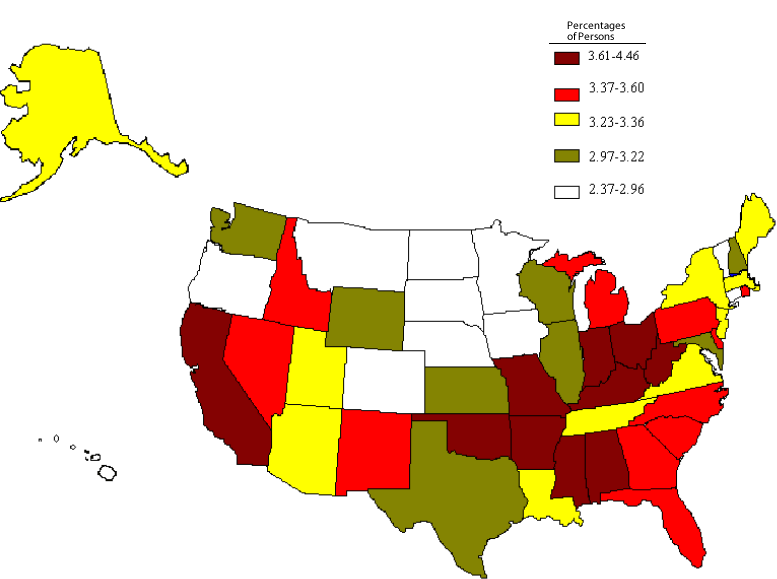
Source: 2006 Behavioral Risk Factor Surveillance System.
Age-Adjusted Suicide Rate in Each State per 100,000, 2004
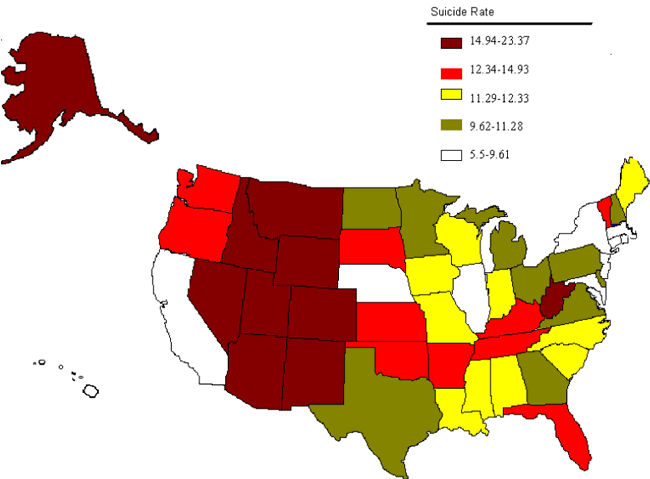
Source: Centers for Disease Control and Prevention, National Injury Mortality Data.


No comments:
Post a Comment